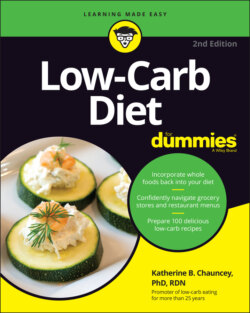Читать книгу Low-Carb Diet For Dummies - Katherine B. Chauncey - Страница 57
Evaluating limits on carbs
ОглавлениеEating a healthy diet on a very-low-carb diet that restricts you to fewer than 50 grams of carbohydrate is impossible. If you tried, you’d be eliminating too many foods rich in vitamins, minerals, fiber, and cancer-fighters. Getting essential nutrients from foods is always better than getting it from supplements.
A moderately low-carbohydrate diet — such as the Whole Foods Weight Loss Eating Plan — includes 100 to 150 grams of carbohydrate per day. Recent nutrition guidelines say that 130 grams of carbohydrate per day is the minimum level needed for adequate brain function in children and adults. This level — also in-line with what the American Diabetes Association recommends — is the minimum to prevent loss of lean tissue from muscles and organs.
If you count the carbohydrate in milk, fruits, vegetables, legumes, breads, and cereals, you’d have 130 grams of carbohydrate from two servings of milk, two servings of fruit, three servings of vegetables, and four servings of legumes, breads, or cereals.
A high-carb diet, on the other hand, includes more than 250 grams of carbohydrate each day. That diet is appropriate for active people who are at a healthy weight (with a BMI between 20 and 25 — see Chapter 4 for more on BMI). No matter how many grams of carbs you eat every day, fruits, vegetables, whole grains, and legumes should be the main food sources of carbohydrates, with added sugar sources kept to a minimum.
The potential physical consequences of very-low-carbohydrate diets range from mild to serious to life-threatening. Because the Whole Foods Weight Loss Eating Plan I recommend is a modified low-carbohydrate diet, you shouldn’t experience any of these problems. But, as with any diet plan, consult your healthcare provider for advice before beginning the plan. Check out Chapter 3 for the physical consequences of very-low-carbohydrate diets.
To evaluate your own lifestyle and health risks to determine if a lower-carbohydrate diet may be good for you, turn to Chapter 4.
